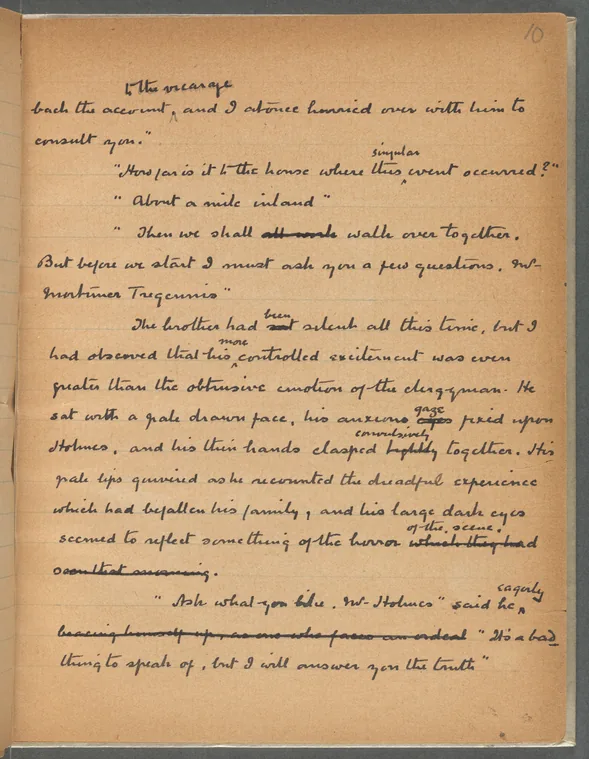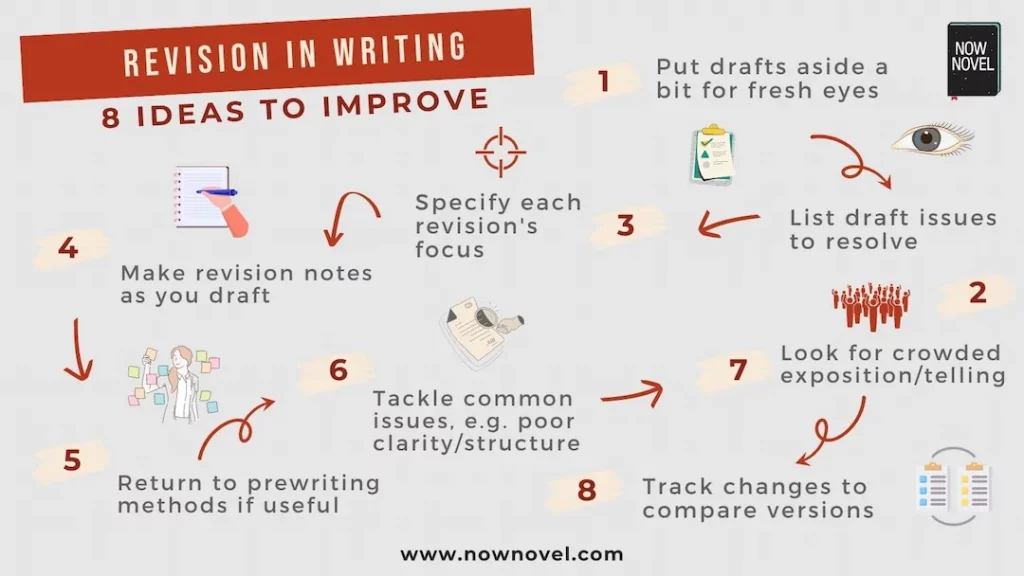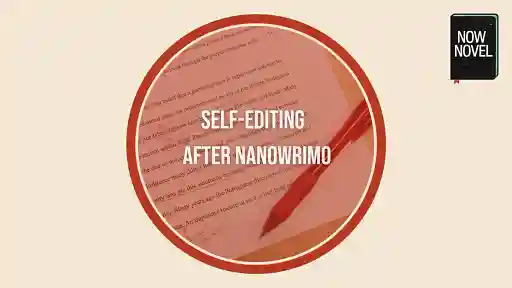Revision in writing is the stage of the writing process during which you rewrite or make changes informed by how they will impact your composition as a whole. Keep reading for ideas on how to improve between drafts, and why revision is important.
Steps and strategies for revision
Revision means 'the process of changing a document, book, etc. in order to improve it, correct mistakes, or make it contain the most recent information' (Cambridge). At root, it means 'seeing again'. How can you go from drafting to productive revising?
-
Put your draft aside for a bit
Distance helps you read your writing with fresh eyes.
-
Write a list of known draft issues
What struck you as awkward or uneven while drafting? List known issues (e.g. a muddled middle) that you can fix in revision.
-
Specify each revision's focus
One revision draft might focus on how you hook your reader from scene to scene. Another, on language details.
-
Make draft revision notes
Comment in the margins or a separate document or spreadsheet with page references.
-
Return to prewriting methods if useful
Go back to outlining (e.g. reverse-outline chapters) if this will help you see the broader sweep of your story.
-
Tackle common rough draft issues
Common first draft issues include overwriting, starting in the wrong place, hazy structure.
-
Look for crowded exposition and telling
The first draft is just you telling yourself the story. It makes sense that you may have crowded early drafts with telling or exposition.
-
Track changes and keep document versions
Use Google Docs versioning. Save separate documents at different stage of revisions so you can still revert on any change.
-
Get a revision assistant
Work with an editor or writing circle who can help you focus on finding changes that will elevate your story.
Let's explore the above tips for revision in writing further:
Put your draft aside for a bit
Drafting, the second stage of the writing process after prewriting, is tiring. Often when we finish a draft, we're too close to the text to think objectively. Change what will serve the work's impact as a whole.
When you finish, as the University of Minnesota's writing center advises, put your first draft aside for a while.
Fresh eyes help you see with emotional distance, making rational decisions that serve your story easier.
This revision strategy is important in fiction, as you need to forget in order to read like a reader/editor - as though reading your own work from a balanced beta reader's POV.
Write a list of known draft issues
As you draft your story or novel, you're likely aware of issues and common writing errors you could later resolve. For example:
- Plot holes: Passages where the story's events don't line up in a clear causative chain
- Overlong chapters: Maybe some chapters could be split into two separate chapters or chunked up with scene breaks for flow
- Lack of clarity or focus: It's hard to bring your a-game the entire time you write. There will likely be uneven patches where your style or story loses focus or the reader could stumble
Although it may seem time-consuming, reading through your draft in full is a good first step in the revision process.
Resist the urge to make changes immediately on a first pass - write down a changelog of things to fix with page references. Revision note examples:
- p. 1 - Cut first paragraph (paragraph 2 stronger hook)
- p. 2 - Ambiguity re: who is speaking, add dialogue and/or action tags
Write in shorthand to make this process as quick as possible. It helps not only to identify issues but also because writing down goals helps you stay on track to achieve them.

Specify each revision's focus
In a writing webinar on memoir, Now Novel writing coach Hedi Lampert shared revision advice given by the late Ann Schuster who ran women's writing workshops in Cape Town for twelve years.
Schuster described a three-stage draft and revision process:
- The down draft: This is where you get all your ideas down, the first draft.
- The up draft: This is where you sweep up everything that is scattered and loose and finesse for what you wanted to say.
- The dental draft: A polishing final draft that fills the finest holes and imperfections, like dentistry.
The helpful thing about doing revision in writing this way (or finding your own three- or more- part process) is that you approach each draft or rewrite with clear, specified revision purpose.
Now Novel writing coach Romy Sommer describes a four-pass approach to drafting in this preview from our monthly webinars:
Depending on your genre or medium, drafting and revision may make different demands on you, emotionally, energy-wise.
For example, Michelle Zauner (memoirist and musician who performs as Japanese Breakfast) said of writing and revising a memoir:
The biggest takeaway from a memoir is that you have to play fair. Within the first draft, I was writing very angrily because I had a lot of resentment and a lot to process. Through revision is where a lot of learning happened and a lot of forgiveness happened.
Michelle Zauner, interviewed by Ellise Shafer in Variety, Dec 8th 2021.
The takeaway is to let each part of the writing process achieve the change you need. One approach seldom fits all.

Meet top editors, designers, and marketers
The best professionals are already on Reedsy. Sign up now to request free quotes.
Make draft revision notes
Some authors annotate as they draft. Some leave comments in the margin. Others print out hard copies and revise on this. Sir Arthur Conan Doyle did the latter:

However you prefer to work, revision in writing is a lot easier when you have process work to refer to.
This may be prewriting such as a story outline. The beginning of revision is a good time to read over this material, and compare - where have you departed? How has the map changed?
[When performing manuscript assessments, I make in-line comments I preface with categorizing labels such as 'Characterization:' or 'Style: Concision'.
This gives me a searchable index of comments by topic I can read through to compile report feedback by writing element, and to locate examples to pull out. This way I can hone in on which aspects of the manuscript would most benefit from further development - Ed's note].
If you like to keep your working manuscript clean, create a table in a separate document with comments and page references to be able to find what you want to improve in a draft quickly.
Return to prewriting methods if useful
During revision, a tricky thing to manage is how you keep an overview of your scenes, chapters, story arcs and ideas.
Many writers use story organizing tools (such as the Now Novel dashboard - tour features here). Our own tools are helpful as there are links back from the document that generates as you go to edit any outline section from your printable PDF summary.
If you pantsed your way through your draft and you don't have an outline, now may be a helpful time to read through your manuscript and summarize the events of each chapter as you go. This may help you to identify places where your story loses narrative drive or focus.
Other prewriting methods it may be helpful to work into revision include brainstorming, freewriting and 'looping' (doing freewriting on a topic, character, or plot point, then doing more to niche down on ideas you came up with).

Tackle common rough draft issues
First drafts are messy by nature. Often when authors seek out manuscript assessments, they share challenges such as 'I need to cut about 20,000 words', for example.
This is a great 'problem' to have for revision. Having written excess material may mean finding brilliant structure is a matter of a few, careful cuts that amp up tension or throw readers into action quicker, for example.
Other common rough draft issues you might focus on in revision include:
- Starting in the 'wrong' place for an impactful beginning (often, the first few pages are just the author easing into the story; finding their feet - or voice)
- Murky clarity and unintentional ambiguity
- Repetitious, fussy, or self-consciously 'literary' style
- Crowding more information than necessary into exposition (info dumps)
If you tend to have many of these issues in first drafts (and the typos and grammar accidents every writer has), a good developmental edit and/or copy-edit and proofreading should follow revision to ensure your manuscript has sufficient polish to proceed to publication.
Look for crowded exposition and telling
One of the common writing errors in early drafts as described above is exposition that tells more than your reader needs.
Showing and telling are both necessary (summary narration is useful, for example, to tell your reader key events that occurred and are relevant to the story but do not need scene-level showing of their own). For example:
'Yesterday was my birthday [telling]. What a great birthday present it is to have this absolute mess of a crime scene first thing on a Monday [telling]. I pull on the gloves. Ugh, let's do this [showing].'
If you were beginning a story with a crime scene investigation, it wouldn't make sense perhaps to show the first part of the above as a scene. However exposition and backstory - especially at the start of a story - is ideally concise so that your reader doesn't have to wait forever for the main events of your story to get going.
Ursula K. Le Guin talks of 'crowding and leaping', a wonderful and dynamic concept applicable to any revision in writing:
Crowding is what Keats meant when he told poets to "load every rift with ore." It's what we mean when we exhort ourselves to avoid flabby language and clichés, never to use ten vague words where two will do, always to seek the vivid phrase, the exact word. [...]
Ursula K. Le Guin, Steering the Craft: Exercises and discussions on story writing for the lone navigator or the mutinous crew, pp. 141-142.
But leaping is just as important. What you leap over is what you leave out. And what you leave out is infinitely more than what you leave in. There's got to be white space around the word, silence around the voice. Listing is not describing. Only the relevant belongs.
So revision is a great opportunity to try to leap or crowd words more or less - whichever expansive or space-creating gesture your story calls for.

Track changes and keep document versions
The revision stage of the writing process has a major pitfall. Upon reading your work, you say 'this won't do' and 'that doesn't work' and so start over from scratch, maybe even saving over your entire document.
Don't. Keep versions so you can at least compare draft one of a chapter to draft four. Recently, a Now Novel member in critique groups began sharing segments of the fourth draft of her story for critique.
The difference is impressive - characters and places colored in detail, sometimes in goosebump-giving ways.
Even if a subsequent draft is much more developed like this and polished (thanks to the time you've spent finessing your story), it's useful to have a record of prior runs. Maybe reading through you'll find passages to transpose straight to your latest draft. You'll at least have a record of how far your story's come.
Google Docs' document versioning system means you can upload documents with the same title and download or revert to specific versions to turn back the clock on specific changes. To do this:
- Open a draft document
- Click File > Version history > See version history
- Click the three dots to the right of the version in the version panel on the right of your screen and choose 'restore this version' to revert to a previous version of a draft.
When you revise, consider also using the 'track changes' feature if using Word or a similar word processor. This way you can keep every change as a suggestion and then make a copy of your draft to implement the changes.
Get a revision assistant
After drafting, the third stage of the writing process often benefits from external perspective. Even if you put your manuscript aside for a week or more, you might still be too close.
A revision assistant such as a writing coach who'll look at your first three chapters and story plan and give feedback will help you begin revising the content and structure of your story.
Revision is an art in itself, as Joyce Carol Oates says:
My reputation for writing quickly and effortlessly notwithstanding, I am strongly in favor of intelligent, even fastidious revision, which is, or certainly should be, an art in itself.
Joyce Carol Oates, quoted in 'The Art of Fiction No. 72', The Paris Review, Fall-Winter 1978.
For more comprehensive feedback, a manuscript evaluation is a reader's report on your complete manuscript. An editing client of Now Novel said of this first editing step (which may be used to guide revision):
A writing circle is an equally useful option for help with revision - many members in the Now Novel community give each other detailed feedback on first or subsequent drafts, each person bringing a unique perspective that helps polish a facet of the writing discussed.
Do you need revision help for your story? Get a free quote for a reader's report or manuscript evaluation now.
Subscribe to our newsletter
One million authors use our writing resources to get their books published. Come join them.










